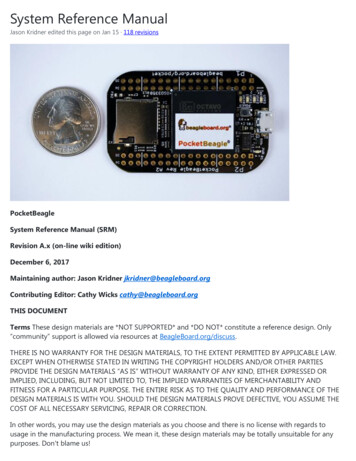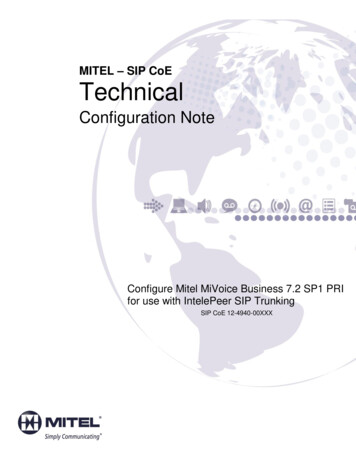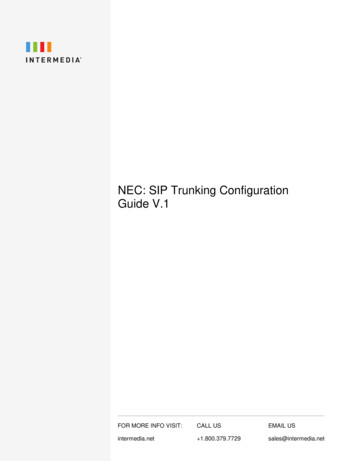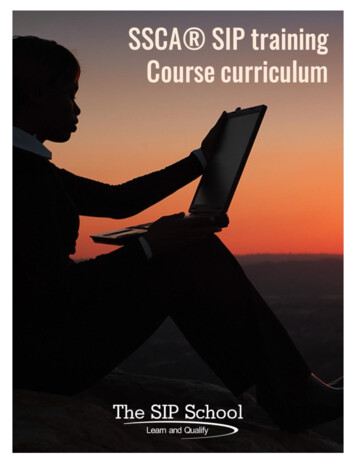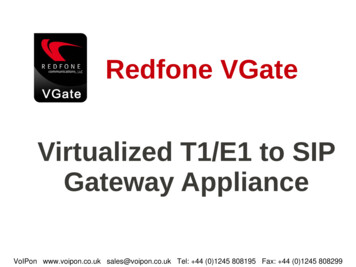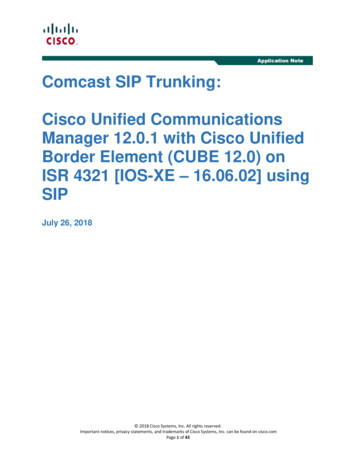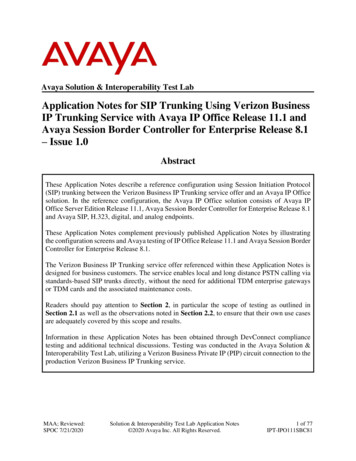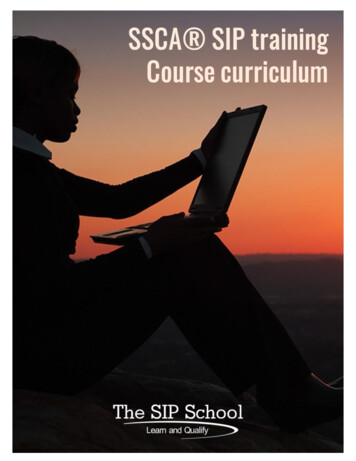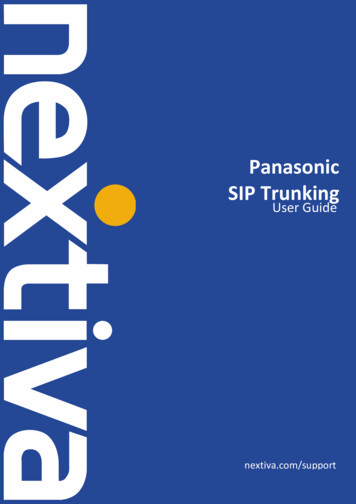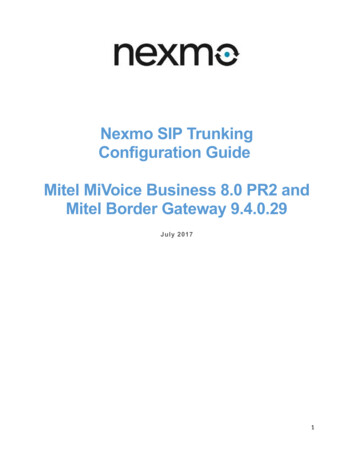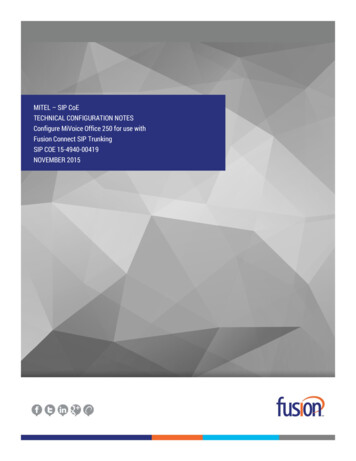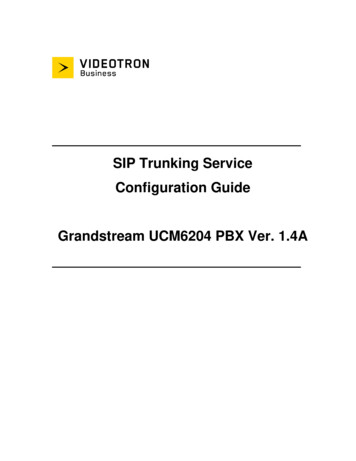
Transcription
SIP Trunking ServiceConfiguration GuideGrandstream UCM6204 PBX Ver. 1.4A
Confidentiality and copyright statementThe information contained in this document is the property of Videotron Ltd. and mustbe kept confidential. The use or distribution of this material without prior consent istherefore strictly prohibited.This document was written using gender-neutral language.The information contained herein is subject to change without prior notice.Modification 9-09-182019-09-30AuthorPascal BeauregardMartin LefrançoisA. MarchardMartin LefrançoisDescriptionOriginal draftReview of the consistency with other manualsLinguistic revisionValidation of the revisionPage 2
Table of ContentsConfidentiality and copyright statement . 2Modification history. 21 Audience . 42 Introduction . 43 Network and equipment diagram . 44 Features . 54.1 Supported features . 54.2 Unsupported or limited features . 65 Service requirements . 85.1 Registering a SIP trunk . 85.2 Responding to SIP INFO messages . 85.3 Sending the domain name in the Req URI header of SIP INVITE messages . 85.4 Configuration settings overview . 86 Configuration . 9Step 1: Configuring the SIP trunking service . 9Step 2: Setting inbound rules . 11Step 3: Setting outbound rules . 127 Glossary . 13Page 3
1 AudienceThe SIP Trunking Service Configuration Guide is intended for service users, technical managers andauthorized integrators.2 IntroductionThe SIP Trunking Service Configuration Guide details the basic steps for setting up a single SIPtrunk between Videotron’s SBC and the Grandstream UCM6204 PBX — you can configure severalSIP trunks following the steps described herein.That said, this guide is not intended to help you configure PBX user/application features.3 Network and equipment diagramThe diagram below is an overhead view of SIP trunking with a Grandstream UCM6204 PBX.VideotronnetworkClient networkClient routerPSTNThe solution includes:Customer site: Telephones PBX Router/Firewall Cable modemVideotron site: Videotron SBC: Oracle (Acme Packet) Videotron Softswitch: Genband C20 PSTN connectionPage 4
4 Features4.1 Supported featuresThe SIP trunking service supports the following features:FeatureSimultaneous callsFaxDescriptionLimit(s)The simultaneous calls limit isestablished when the SIP trunkorder is placed.G.711 µ-law standard usedexclusivelyT.38 standard not supportedG.711 µ-law standard usedOther kinds of data (modem, alarm, etc.)G.711 µ-law standard usedInbound Caller ID name and numberInbound Caller ID name andnumber transmitted from theVideotron site to the PBX.Outbound Caller ID nameOutbound Caller ID name, astransmitted via PBX to thepublic network.Outbound Caller ID number, astransmitted via PBX to thepublic network.DID display for 911 emergencycall centre transmitted via PBXif on the predefined list ofnumbers.Calls are routed to another SIPtrunk when the number ofsimultaneous calls SIPtrunking can handle isexceeded.Calls are routed to anotherphone number when thenumber of simultaneous callsthat the SIP trunk can handleis exceeded.VoiceOutbound Caller ID numberDID display for 911 emergency call centreDirect trunk overflowFailover to another phone numberFailover to another SIP trunkThe other SIP trunk must be onthe same Videotron telephoneswitch as the primary SIP trunk.The “Redirect information” or“Original called number” field isnot transmitted. The “Callednumber” is the actual forwardingnumber and not the DID.An overflow to another phonenumber requires an additionalservice called a “PermanentRedirect Line (PRL).” Thisservice is billed according to thepredefined number ofsimultaneous PRL calls. If thephone number is long distance,charges will apply.Calls are routed to another SIP If the PBX responds with a SIPtrunk in the following threemessage other than “503cases of failure:Service Unavailable,” there will1. The customer’s PBX nobe no call failover.longer responds to callssent to it on the SIP trunk.2. The customer's PBXresponds with the message“SIP 503 ServiceUnavailable.”Page 5
3. The SIP trunk is faulty.Failover to another phone numberCalls are routed to anotherphone number in the samethree cases as above.“Redirect number” field (Remote Party ID)Class of restriction call blockingNo blocking for local calls, inQuebec, Canada, the UnitedStates and abroad, and for411, 0-, 0 , 00 and 900numbers.Number portabilityVideotron handles thetransfer of a customer’stelephone number fromtheir current service tothe SIP trunking service.SIP-ReferEnables you to free uplines after a call isforwarded from anexternal number toanother external number,such as a cellphone.If the PBX responds with a SIPmessage other than “503Service Unavailable,” there willbe no call failover.Same limitation as “Direct trunkoverflow” with respect to thefields and the need for aPermanent Redirect Line.The Videotron telephone switchtransmits the original callednumber to the Remote-Party-IDheader.1-976 calls are blocked.The customer must provide allrequired documentation.If the external number is longdistance in relation to theoriginal dialled number, the callmay be dropped rather thanforwarded. Especially when thecall is transferred throughanother Videotron switch.Routing between Videotronswitches is subject to changewithout prior notice.4.2 Unsupported or limited featuresOur SIP trunking does not support the following features:FeatureNumbers outside our coverage areaFixed 911Emergency call forwardingAuthorization and billing codesDescriptionOnly telephone numbers in Videotron service areas will beaccepted.This feature allows calls to be forwarded directly to the 911emergency call centre in the municipality where the caller islocated. Instead, the SIP trunking service uses an intermediary(“nomad”) 911 emergency call centre to forward calls. Seevideotron.com/ip-911 for details.Allows you to forward calls to different destinations based on apredefined phone tree for emergency scenarios. This is anadvanced feature reserved for the dedicated fibre optic SIPtrunking service.The authorization code is used to limit access to long-distancecalls. The billing code is used to count calls per user for internalbilling and customer billing purposes.These are advanced features reserved for the dedicated fibreoptic SIP trunking service.Page 6
Equity of accessOccasional callsSignalling and voice channel encryptionAllows you to use another long distance provider. This feature islargely irrelevant considering that Videotron offers unlimitedcalling plans for Canada and the United States. This feature isreserved for the dedicated local fibre optic SIP trunking service.Used to dial the 101-XXXX code in order to temporarily changelong distance provider. This feature is largely irrelevantconsidering that Videotron offers unlimited calling plans forCanada and the United States. This feature is reserved for thededicated local fibre optic SIP trunking service.Videotron does not currently support signalling encryption (SIPTLS) and voice channel encryption (SRTP). Encrypted MD5 hashpassword.Page 7
5 Service requirements5.1 Registering a SIP trunkOnce the SIP trunk has been configured at the Videotron site, our technical team will send thefollowing information to the customer: domain nameusernamepasswordThe customer PBX must be registered with Videotron in order to connect calls via SIP trunking. Thecustomer, or more commonly the integrator-interconnector, must configure the PBX such as toregister the SIP trunk with Videotron’s switch. The Videotron team will set up a phone conferencewith the interconnector to complete the registration and ensure the SIP trunk is functioning properly.The PBX is registered by sending SIP REGISTER messages to Videotron’s SBC IP address. Thesemessages contain a username, password and domain name.5.2 Responding to SIP INFO messagesVideotron’s telephone switch periodically sends SIP INFO messages to the customer’s PBX. Ifthese messages do not reach the PBX (i.e., they are blocked by the customer’s firewall), or the PBXdoes not answer, the switch will consider the PBX out of order.5.3 Sending the domain name in the Req URI header of SIP INVITE messagesThe PBX must be capable of sending a domain name in the Req URI of SIP INVITE messages. Ifthe domain name is missing, any calls will be rejected.5.4 Configuration settings overviewThe table below provides an overview of the settings required to set up the SIP trunking service.Domain nameVideotron SBC addressSIP communication portUsernamePasswordNumber of simultaneous calls on theSIP trunkCodecFax protocolDTMFSIP REFERProvided by Videotron: customeracronym .sipott.v50.videotron.com24.200.242.87UDP 5060Provided by Videotron: s last 9 numbers of primarytelephone number E.g., s143801234Provided by Videotron: 12 alphanumeric characters with atleast 1 lowercase letter, 1 uppercase letter, and 1 numberE.g., aQkTZaxvHz7phrLYProvided by VideotronG.711 µ-law onlyIn-Band (T.38 not supported)RFC2833The SIP REFER function must only be activated afterdiscussion with the Videotron team. If the external numberis long distance in relation to the original dialled number,the call may be dropped rather than forwarded.Table 1: Configuration settings overviewPage 8
6 ConfigurationStep 1: Configuring the SIP trunking serviceIn the Extension/Trunk section, select VoIP trunks and then Create New SIP Trunk.Ensure that the following values are entered or selected in the Basic Settings tab: Provider Name : A name that describes your SIP trunk (e.g., Videotron)Keep Trunk CID : SelectedNeed Registration : SelectedFrom Domain : Domain name provided by Videotron (e.g.,cust01.sipott.v50.videotron.com)Username : SIP User ID provided by VideotronAuthID : Username provided by Videotron (same as Username)Transport : UDPHost Name : SIP User ID provided by VideotronNAT : SelectedTEL URI : DisabledPassword : Authentication Password provided by VideotronPage 9
Domainnameid DomainnamePasswordUsernameSelect the Advanced Settings tab.Ensure that the following values are entered or selected: Codec Preference : PCMU (This is the only codec supported by Videotron.)Outbound Proxy Support : sélectionnéOutbound Proxy : 24.200.242.87:5060DID Mode : To-HeaderDTMF Mode : RFC2833The Maximum Number of Call Lines : The number of simultaneous calls ordered bythe customerFax mode: NoneSRTP: DisabledIP AddressNumber ofSimultaneous callsPage 10
Step 2: Setting inbound rulesThis section explains how to configure inbound routes. These routes are activated when thePBX gets a new call from the SIP trunk. These routes direct incoming calls to theappropriate PBX destination (voice menu, voicemail, telephone, etc.) based on the numberdialled.In the Extension/Trunk section, select InBound Routes and click on Add. You must thenselect the SIP trunk created in step 1.Ensure that the following values are entered or selected: Pattern : Enter one of the DID numbers assigned to the SIP trunk (e.g., the primarynumber) preceded by . You can also use the special characters “X,Z,N,.,!” to createrules that apply to a range of dialled numbers instead of just one.Disable This Route : Not selectedAlert-info : NonePrepend Trunk Name : Not selectedInbound Multiple Mode : Not selectedDefault Mode – Default Destination : Enter a default destination for this rule. The optionsare: Extension, Conference, Call Queue, Ring Group, IVR. For some options, a seconddestination can be selected. E.g., Extension, you must specify the extension.Time Condition : You can enter other destinations than the default destination, basedon the day and time.Page 11
Step 3: Setting outbound rulesThis section explains how to configure outbound routes. These routes are activated whenPBX lines dial numbers with a specific sequence. When the conditions that suit this routeare met, the call will be made from the PBX by the destination specified by this route. Theseroutes direct outbound calls to Videotron’s SIP trunk.In the Extension/Trunk section, select OutBound Routes and click on Add.Ensure that the following values are entered or selected: Calling Rule Name : a relevant name for this rule (e.g., Videotron)Pattern : You must enter the number sequences that refer to the outbound callpossibilities for the components of your PBX. The sequence must always begin with“ ”. You can use the special characters “X,Z,N,.,!” to create rules that apply to a rangeof dialled numbers instead of just one.Disable This Route : Not selectedPassword : It is left empty.Main Trunk – Trunk : Select the SIP trunk created in step 1.Main Trunk – Strip : You can delete a part of the numbers dialled before they are sent tothe SIP trunk.Main Trunk – Prepend : You can add a number sequence at the beginning of the diallednumbers before they are sent to the SIP trunk.Page 12
7 Glossary503Service unavailableServer error code.burstingFeature that enables you to temporarily exceed the simultaneous calling limit stipulated inyour contract. Simultaneous calls are billed on a pay-per-use basis. Feature currently indevelopmentcalled numberNumber called or requestedcalled partyPerson to whom a call is sent.calling partyPerson sending a call to establish communication.C20Videotron telephone switchCO linecentral office lineCommunication line that connects a PBX to a telephone service provider’s switchboard.G.711Digital voice encoding standardH.323Standard for transmitting audio, data and images in real time across packet networks. Used for localnetworks, like an intranet, or public networks, like the Internet.Less commonly used than SIP.IPInternet protocolIP-GWIP gatewaykey systemIntercom system, key telephone systemThe most commonly used telephone system when few additional extensions are required. Enablesusers to call each other directly and to communicate with public network subscribers through outboundand inbound calls.original called numberPBXprivate branch exchangeA company’s private telephone switchPSTNpublic switched telephone networkredirect informationREFERSIP method for transferring calls whereby the call is sent to a number indicated in the transfer request.Enables you to free up lines after a call is forwarded from an external number to another externalnumber, such as a cellphone.PSTNpublic switched telephone networkSBCsession border controllerA network element to monitor and protect SIP-based communications from fraud and enabling you toconfigure SIP trunk settings.DIDdirect inward diallingTelephone feature enabling an outbound caller to reach a subscriber directly without going through anoperator or dialling an extension. DID number.SIPsession initiation protocolLogin protocol used in IP telephony. Refers to an IP telephony service allowing a telephone switch toaccess the PSTN, thereby supporting the management of call signalling, over IP links using SIPtrunking.Page 13
Softswitchsoftware switch, media gateway controller, call controller, call serverInterconnection equipment that manages the operation of a media gateway that allows signals carryingvoice, data or images to move from a circuit-switched public telephone network to a private packetswitched network, such as a private IP network—or to go in the reverse.T.38trunkEncoding standard for sending faxes across IP networks in a real-time mode.CircuitA line that connects switches with each other and is used to route information sequentially.trunk group; TGCircuitry starting from a single switch and terminating at one or more switches giving access to thesame subscribers. In the specific case of the Videotron SIP trunking service, TG refers to a SIP trunk.In certain exceptional situations, there may be more than one TG or multiple SIP trunks between aPBX and Videotron.Page 14
Failover to another SIP trunk Calls are routed to another SIP trunk in the following three cases of failure: 1. The customer's PBX no longer responds to calls sent to it on the SIP trunk. 2. The customer's PBX responds with the message "SIP 503 Service Unavailable." If the PBX responds with a SIP message other than "503
